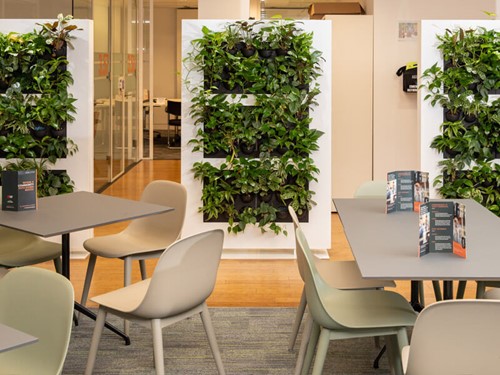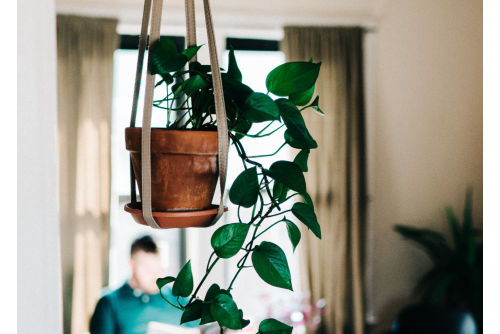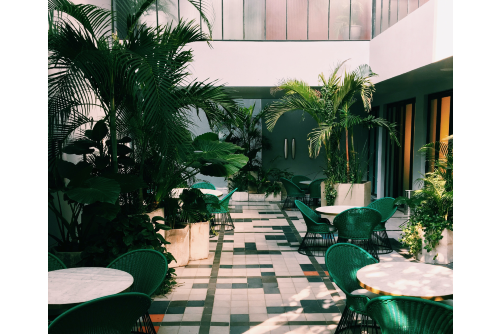Bringing Biophilic Design to Life in Your Environment
Bringing Biophilic Design to Life in Your Environment
If you haven’t yet heard of biophilic design, you soon will.
Fast becoming one of the biggest buzzwords in interior design, biophilia is starting to be adopted within buildings across the country.
But biophilia is more than just a flash in the pan. With the benefits biophilic design can bring to health, wellbeing and productivity, this is one trend which is far more than aesthetic; it’s here to stay.

What is biophilia?
Biophilia was first coined by psychologist Erich Fromm in the 1970s who believed humans had a “passionate love of life and all that is alive”. He classified biophilia as a biological human instinct. The theory was expanded in the 1980s in the Biophilia Hypothesis which is the idea that humans need to connect to nature.
However, in modern life, the amount of time we spend surrounded by nature or even outdoors at all is limited. It’s estimated that we spend around 90% of our entire time indoors which means that our inherent need to connect with nature is being neglected – and we’re missing out because of it.
What is biophilic design?
Biophilic design is the concept of connecting our environment with nature, thereby creating indoor habitats which fulfil our needs and bring about physical and emotional benefits.
By tapping into nature in the places we spend time, whether that’s in an office, workplace or even places of leisure such as restaurants, pubs and shops, we’re reconnecting with nature – and experts believe it makes a big difference to the way we live and work.
What are the benefits of biophilic design?
Biophilic design doesn’t just look good, it brings with it a host of benefits which have been proven by research over the last four decades. Exposure to nature and greenery is reported to reduce stress, boost focus and productivity and even increase immunity, aid healing and enhance both short and long-term mental health.
Here’s just some examples:
- A review of more than 50 studies found that environments devoid of nature correlated to negative effects on health and wellbeing.[i] However, workers with nature incorporated into the workplace report significantly higher levels of wellbeing.[ii]
- The Human Spaces Global Report discovered those who worked in environments with natural elements reported a 15% higher level of wellbeing and creativity.
- Researchers at Cardiff University found green offices make staff happier as well as 15% more productive.[iii]
- A Danish study in 2019 found children with greener surroundings have up to 55% less risk of developing various mental disorders in later life.[iv]
- A Californian call centre found workers with views of vegetation handled calls around 7% faster. After making changes to workstations, it generated annual productivity savings of nearly $3,000 per employee.[v]
- Healthcare facilities with biophilic design have actually experienced quicker post-surgery recovery time for patients.[vi]
With these purported benefits, there’s a compelling argument to incorporate biophilic design into your building. It doesn’t just a nice to do, it’s verging on necessity!

How to incorporate biophilic design into your space:
Companies are certainly buying into the theory of biophilic design and there are some incredible examples created for the likes of Google, Apple, Amazon and Adobe. However, if you don’t have a Silicon Valley budget, you can still incorporate biophilic design into your environment easily and affordably, going on to reap the associated benefits.
phs Greenleaf’s guide to biophilic design:
- Views: Consider what people are looking at within your environment. Are they facing bare walls or blank space? Wherever you can, maximise the use of windows even if it means rearranging furniture. Even pictures of nature make a difference so if you don’t have windows, use artwork and nature-inspired décor as an alternative
- Daylight: Natural lighting boosts wellbeing by tapping into our circadian rhythms. Let in daylight through windows, sky lights and doors. If there are bright sunny spots, consider making this a focal point for people to gather or relax. And when it comes to artificial lights, explore circadian smart lighting which adjusts the colour temperature throughout the day to mimic natural daylight.
- Introduce greenery: Biophilia is about more than just putting a pot plant on a desk, although that’s a start. How can you green your reception area, meeting spaces, corridors and stairwells? Think about novel ways you can introduce greenery whether it’s through indoor gardens, installing trees and shrubs, hanging baskets, planters hanging from ceilings or green artwork. Living walls are a feature growing in popularity for both outdoors and indoors, transforming workplace environments. Remember that greenery can also be functional with living walls doubling up as room dividers and planters featuring within hand sanitising stations, signage and for social distancing.
- Places to spend time: Transform any outdoor space into a green environment where people can meet or even just visit while taking a break. This could be a full-on courtyard, a rooftop garden or simply introducing picnic areas surrounded with shrubs and plants. And indoors, can you be creative and build green spaces into your reception, communal spaces or meeting rooms?
- Indirect nature: Introduce biophilia indirectly such as in the materials and shapes within your space. Swap man-made lines and angles for soft waves and curves you’d find in nature. Biomimicry is the concept of mimicking nature in design so this could include introducing natural patterns, shapes and structures; think about what complements your natural surroundings and how you can mimic it indoors.

Getting help with biophilic design
phs Greenleaf has more than 25 years’ experience of providing planting and landscaping services to businesses across the UK. With knowledge across the sectors, including hospitality, retail, FMs, public sector and workplaces, phs Greenleaf offers a wide range of services including indoor and outdoor planting, artificial and live planting, living walls, ground maintenance and Christmas decorations.
Get in touch now for a free biophilic design consultation. Call 0800 0902325 or email greenleafenquiries@phs.co.uk
[i] https://www.ncbi.nlm.nih.gov/pmc/articles/PMC2760412/
[ii] https://greenplantsforgreenbuildings.org/wp-content/uploads/2015/08/Human-Spaces-Report-Biophilic-Global_Impact_Biophilic_Design.pdf
[iii] https://www.cardiff.ac.uk/news/view/47147-flower-power
[iv] https://www.sciencedaily.com/releases/2019/02/190226112426.htm
[v] https://www.bbc.com/worklife/article/20161125-why-you-cant-afford-to-ignore-nature-in-the-workplace
[vi] https://mcdmag.com/2018/04/natures-cure-how-biophilic-design-can-enhance-healing/
Get In Touch Today!